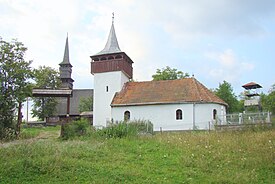Bucureșci
Bucureşci [ bukureʃtʃ ʲ ] (deprecated Bucureşti; Hungarian Bukuresd ) is a municipality in the district of Hunedoara in Transylvania, Romania.
The place is also known under the outdated names romanian Bucurestii de Sus and Bucurestii de Jos and the Hungarian Alsóbukurest and Felsőbukurest.
Geographical location
The municipality is located in the Bucureşci Brad sink ( Depresiunea Bradului ) north of the Transylvanian Erzgebirge ( Munţii Metaliferi ), in the historic district chair Brád (now Bradford ) of the Hunyader county (county iron market). River of the same - a left tributary of the Crisul Alb ( White yelp ) - and the county road (drum Judetean ) DJ located 741, the site is located about 10 kilometers east of the town Brad ( Tannenhof ); the district capital Deva ( Deva ) is located about 45 kilometers south of Bucureşci away.
History
A documentary mention of the place Bucureşci is only since the Josephine land survey of 1769-1773 under the names F. Bukaresd (Upper Bukaresd ) and A. Bukaresd known (sub Bukaresd ). In the Josephine map are registered ramming several mills in the hamlets of Upper and Lower Bukaresd ever a church and along the creek.
An occupation of the site is sufficient because of the gold deposits in the area of community - back to Roman times - according to data from M. Pálfy.
After the collapse of gold mining in the region, many people have left the church or are now mainly engaged in the timber industry.
Population
Since the official survey of 1850 Romanians were predominantly registered on the territory of the present municipality. The highest population ( 3,169 ) - and at the same time the Romanians ( 3151 ) - 1910 was determined. The highest number of Roma population (38 ) in 1930, which the Magyars (9 ) in 1966 and the German of Romania ( 5) was registered in 1910. 2002 were counted in the community Bucureşci 1,924 people. Furthermore, it was 2002, a Ukrainian registered. In the 2011 census, 1,553 people were counted in 632 households in the community.
In addition to forestry - the main activity - are the bee-keeping and the collection of forest fruits appreciable activities of the population.
Attractions
- The wooden church Sf. Nicolae, built in 1785 in eingemeindeten village Curechiu, has numerous painted on wood and glass icons and is a listed building.
- The wooden church Înălţarea Sf. Cruci, 1780, and the estate of the family Jurca built in the 19th century in eingemeindeten village Rovina, are national monuments.
Pictures of the wooden churches
Wooden church in Curechiu
Wooden church in Rovina
The hamlet of Upper and Lower Bukaresd in the Josephine land survey of 1769-1773








